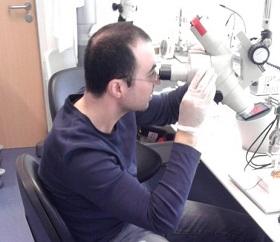From Architecture to AI-Powered Building Diagnostics: Tarek Rakha’s start-up story
10 June 2025
Published online 3 February 2014

A major study into the link between pesticide exposure and a high incidence of Parkinson's disease (PD) in Egypt hopes to explore the relative influence of environment and genetics on the condition.
A new collaboration between Egyptian and German neurologists will try to establish the causes behind a higher prevalence of the neurodegenerative disease in Egypt, especially among communities of farmers and those based in rural areas.
There is a dearth of comprehensive nationwide studies into PD, but a community-based survey carried out by Assiut University was prompted by the large number of PD patients being admitted to the Assiut University Hospital. The newly-formed Egyptian Network of Neurodegenerative Disorders (ENND) has used this research as a launching pad to try to fill the research gap and determine if environment and/or genetics are key factors in PD prevalence.
Eman Khedr, a neurologist at the Assiut University Neuropsychiatry department who led the study, says: "Assiut University is a pioneer in the use of non-invasive brain stimulation as a therapeutic tool of various neurological disorders, including PD."
ENND is a collaborative effort between the Technical University Munich (TUM) and Mansoura University (funded by the German Academic Exchange Service). Sixteen universities in Egypt joined and will collect data on PD patients across the country.
Mohamed Salama, a toxicologist at Mansoura University and the Egyptian ENND coordinator, and Günter Höglinger, a neurologist at TUM's department for Translational Neurodegeneration, have obtained a grant from the German Academic Exchange Service to study the interplay of the genetic background and pesticide exposure in the etiology of PD patients in Egypt.
Neurology in Egypt mostly focuses on treating patients rather than producing scientific research.
"There is an unusually high exposure to pesticide due to the geographic and agricultural conditions in Egypt," says Höglinger.
Salama points not only to the liberal use of pesticides, but also to the mode of exposure. "Basic precautionary measures while spraying are not respected in Egypt. Farmers don't cover their mouths, wear gloves or wash their hands afterwards, so even if the pesticide and the dose sprayed is similar to that of other countries, the exposure is greater," he says.
Over the past year, the researchers collected information from PD patients around Mansoura and found their profiles were usually similar – farmers with a high exposure to pesticides.
Mansoura is an agricultural area, so for an objective study they need access to all Egyptian demographics.
Salama and Höglinger are looking for mutations in genes that would normally rid the body of toxic matter after exposure. "If these genes were not damaged in the first place, they would be able to get rid of ordinary doses of pesticides in a day," says Salama. But if the genes are faulty, the detoxification process can take up to a week, which results in longer exposure to toxic matter.
For Höglinger, the establishment of the new network is a major advance for their current study and for neurological research in Egypt. "Neurology in Egypt mostly focuses on treating patients rather than producing scientific research," says Salama, who hopes the technical support TUM provides can help Egyptian researchers publish in high impact journals, allowing them "to apply for bigger grants in the future."
The participating universities will gather information on PD patients and determine the stage of the disease before classifying them as either "pesticide-exposed" or non-exposed. They will also monitor control groups of highly-exposed people who have not developed the disease in order to confirm if a person's genetic profile can affect sensitivity to pesticide exposure.
Salama says all Egyptians are exposed to varying levels of pesticides to various degrees, and classifies this exposure into three categories: a high exposure group which consists mostly of farmers, a middle exposure group that encompasses rural dwellers, and a low exposure group of urban citizens who are exposed to a lower level of pesticide through food. He added that 200 PD patients have been identified for the study, but that at least 2000 subjects were needed to produce solid results.
doi:10.1038/nmiddleeast.2014.35
Stay connected: